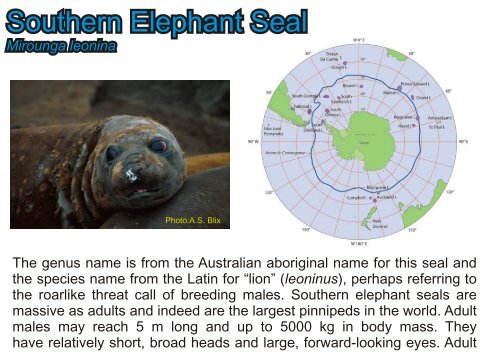Southern Elephant Seal - Seals.scar.org
Southern Elephant Seal - Seals.scar.org
Southern Elephant Seal - Seals.scar.org
You also want an ePaper? Increase the reach of your titles
YUMPU automatically turns print PDFs into web optimized ePapers that Google loves.
<strong>Southern</strong> <strong>Elephant</strong> <strong>Seal</strong><br />
Mirounga leonina<br />
Photo:A.S. Blix<br />
The genus name is from the Australian aboriginal name for this seal and<br />
the species name from the Latin for “lion” (leoninus), perhaps referring to<br />
the roarlike threat call of breeding males. <strong>Southern</strong> elephant seals are<br />
massive as adults and indeed are the largest pinnipeds in the world. Adult<br />
males may reach 5 m long and up to 5000 kg in body mass. They<br />
have relatively short, broad heads and large, forward-looking eyes. Adult
males have slightly enlongated noses, though far less exaggerated than<br />
those of the species’ closest relative, the northern elephant seal (M.<br />
angustirostris). The pelage is light to dark brown dorsally and lighter<br />
brown to yellow ventrally, but always lighter ventrally. Pups are born<br />
with a longer black pelage which is shed just after weaning and replaced<br />
by adult-like hair. Females give birth in September and October, nurse<br />
the single pup for about three weeks and then are mated. They then go to<br />
sea to feed for about two months before returning ashore for about three<br />
weeks to molt in December and January, and then return to sea to forage<br />
for another eight months. Adult males fast while ashore for two to three<br />
months, from August through November, and then return to sea to forage<br />
before returning to land to molt in February and March. They then return<br />
to sea several weeks later and forage for another five to six months.<br />
<strong>Southern</strong> elephant seals are deep divers, feeding mostly at depths of 400<br />
m to 600 m, and occasionally as deep as 2000 m. Their diet is mostly<br />
deep-water squid and lantern-fishes. When foraging they range over<br />
great distances in the southern ocean, principally focusing their activity<br />
at ocean current boundaries, near seamounts and upwelling areas along<br />
the Antarctic contintent. Virtually all of their breeding colonies are on<br />
sub-Antarctic islands, except the largest at South Ge<strong>org</strong>ia which is just<br />
within the Antarctic Convergence boundary. There are, however,
small colonies on islands along the western edge of the Antarctic<br />
Peninsula and a robust and growing colony on the coast of Argentina.<br />
Colonies in the Indian Ocean sector of the Antarctic declined by about<br />
80% from the 1960s through the early 1990s and may have stabilized<br />
since. The cause(s) of the decline is unknown but thought to be related<br />
to variable and reduced prey abundance having effects on<br />
juvenile and adult female survival.


